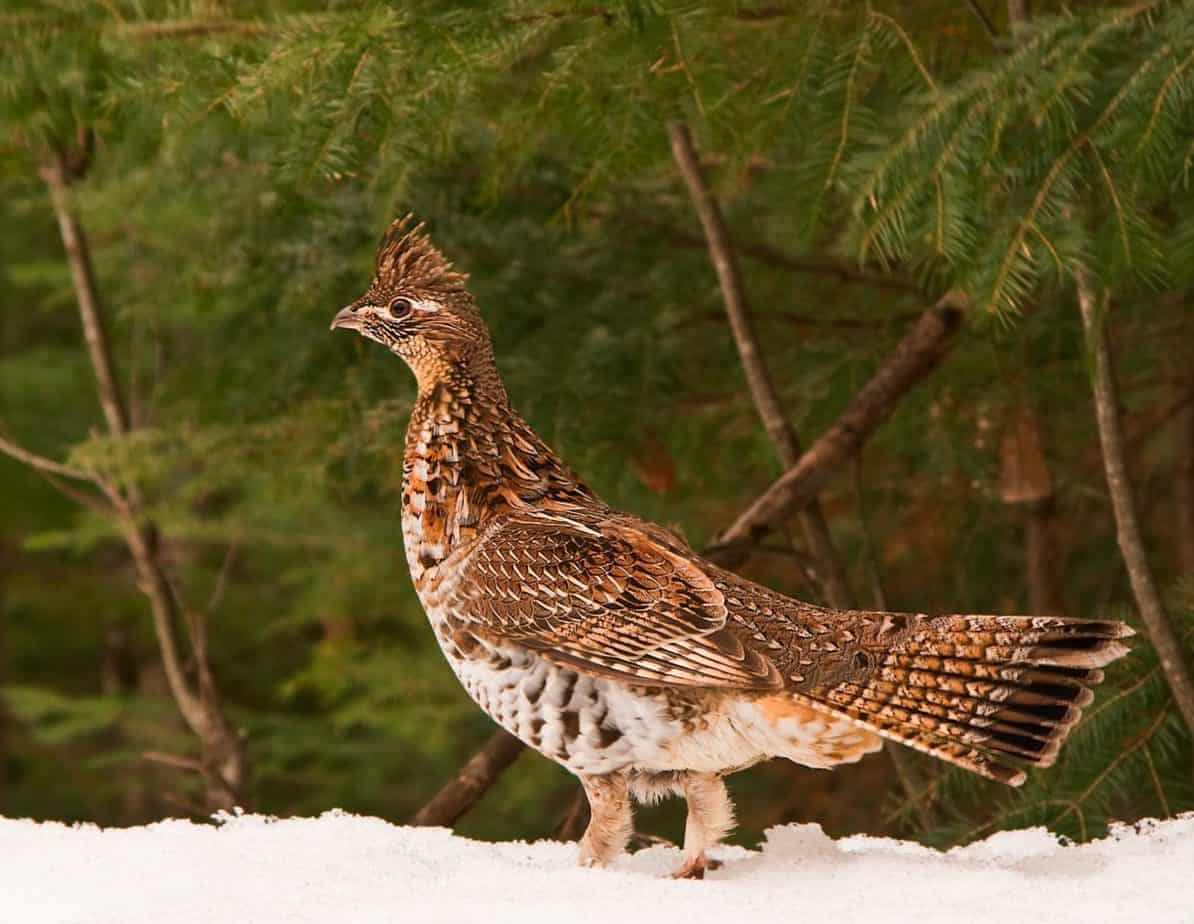While it is certainly true that the majority of hunters chase grouse with the help of a seasoned pointer or setter, hunting grouse with no dog has always been done as well. However, to be successful, you will have to change your strategy to compensate for the lack of a dog.
Here are five things to consider if you plan to hit the woods this fall without a dog:
Find the Right Cover
The Ruffed Grouse (bonasa umbellus) are legendary as a pursuit, and the upland hunter will not find a more challenging or noble adversary.
There is a reason that they are known as the “king of the game birds” in North America, and for good reason.
These birds make you work for them. I don’t mean just a lot of walking. I mean, ducking, bobbing, and weaving in and out of cover like a boxer in the ring.
These game birds dwell in the most thick and unforgiving habitat, no matter what region you find yourself hunting for them.
While there are many grouse hunting purists who would never even think of attempting to fill a game bag without a dog, this is really a question more about subjective taste than about whether or not it’s possible.
Just remember, because you won’t have the dog’s nose to help you locate birds, it is even more important to find the most pristine cover in order to greatly increase your odds of success.
Grouse Habitat
Appalachian Region
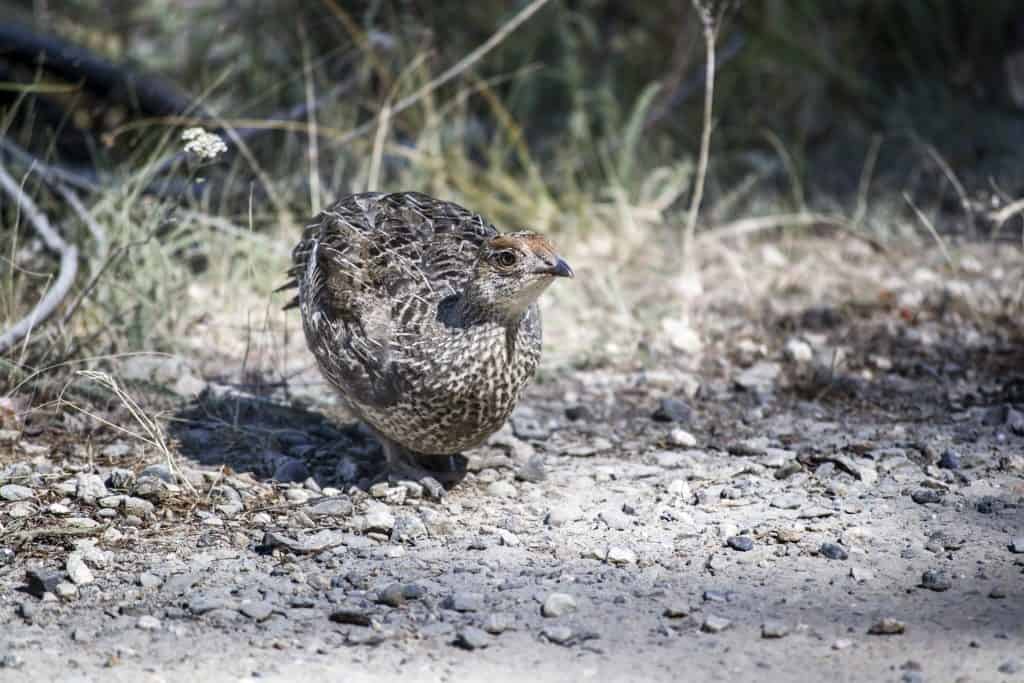
Ideal habitat for grouse will differ depending on what region you’re hunting. The Appalachian region runs from Pennsylvania all the way down to Georgia.
In light of this mountainous region, Ruffed Grouse inhabit a much more volatile landscape full of rolling series of steep mountains, strip mines, and low areas where creeks and rivers have eroded away small valleys.
Look for these low areas that feature balances of young Oak and Pine. Small canopy cover such as green briar, honeysuckle, wild grape, or hawthorn berries will provide even more specificity as you zero in on the best grouse habitat.
Since grouse everywhere thrive in young forests, your best bet will be to find areas that have been cut or disturbed by natural causes within the last five to ten years. The young growth will provide an excellent source of cover and should be obvious to the eye.
North Woods
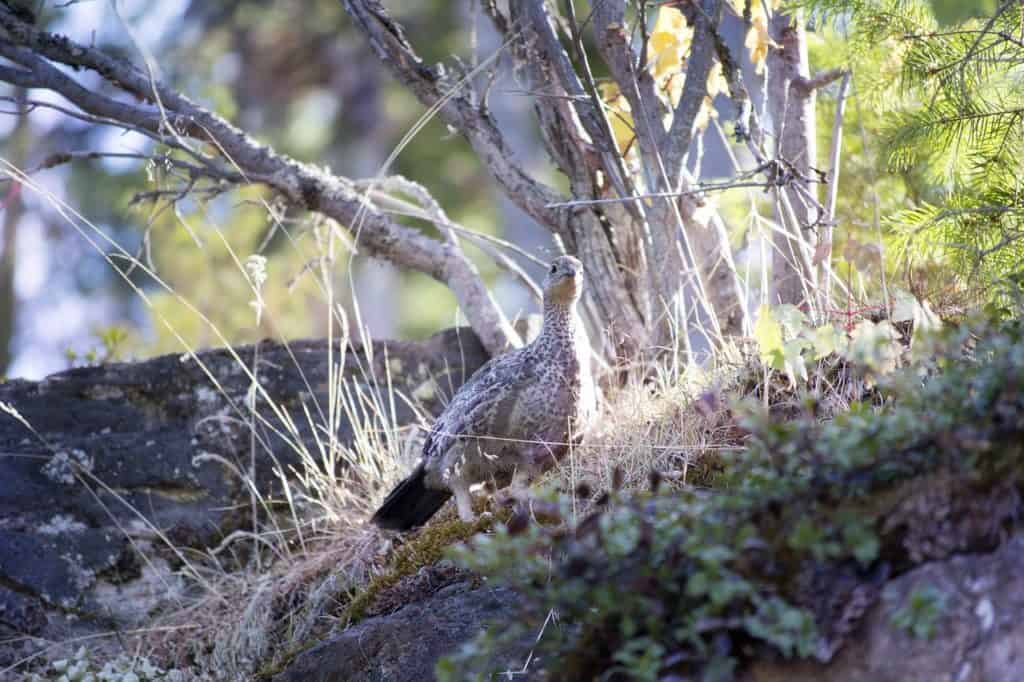
The habitat of the north woods is different. We might think of this region as the north Midwest “Great Lakes” region, or even New England and the North Pacific.
These areas are just as rugged as their Appalachian counterparts but in a different way. These regions are not quite as geographically volatile and contain different landscapes.
The grouse in these regions love to feed on Aspen buds, which is the primary type of cover you will want to seek out in states such as Michigan, Wisconsin, and Minnesota.
Seek out white Aspen or other types of Poplar, as these are by far the most productive areas for northern grouse. Look for sprawling sets of Aspen 15 years and younger. Ideally, Aspen or Alder stands that are no bigger than your forearm are a good rule of thumb.
Rocky streams flanked by thick stands of Cedar or other conifers are also productive areas, especially if the weather is turning towards rain or if there is accumulated snow.
This type of cover is important as it allows refuge for Grouse in the winter once the foliage has started to come off the trees. Finding these types of areas is necessary whether you have a dog or not.
Gear Up
You may not think of gear as being variable as to whether or not you’re hunting with a dog. However, hunting without a dog may require you to take a more “hands on” approach to covering ground and may require you to don different attire than what a hunter would wear if hunting with dogs.
Be warned, if you want the best chances of flushing birds, you will be required to enter some very thick, jungle-like stands of cover where thistles and thorns are the name of the game.
I cannot put into words how many times I have gotten stuck in the clutches of thick cover, only to be rendered completely paralyzed when a grouse flushes at my feet.
If you want to make it through the thicket without being stuck or torn to bits, you will want to take precautions and invest in the appropriate kind of gear that can both protect you from injury as well as take some serious punishment from nasty cover as well as providing much-needed protection from the elements.
Trust me, you don’t want to spare expenses here. Make sure to invest in something that is going to hold up, at least for a while.
Waxed Canvas?
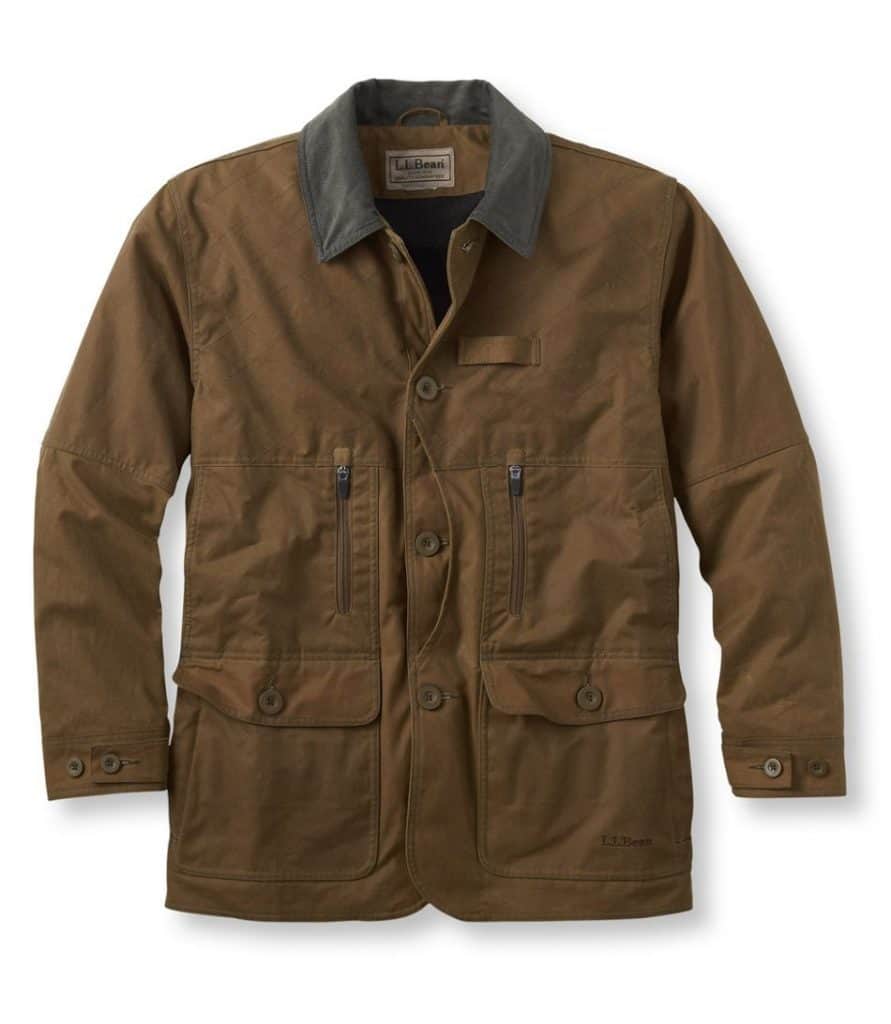
First and foremost I would recommend waxed canvas as the supreme garment for grouse hunters in general, and especially for the person running without a dog.
These come as pants, coats, hunting vests, and even hats and gloves. To start, the water-repelling properties of waxed canvas (also sometimes called waxed cotton), will keep you from retaining water in your outer garments while keeping under-layers dry.
This also helps to keep you light, as water-logged materials become very heavy to endure. Another plus with this type of garment is the durability.
The waxed material allows the garments to seamlessly glide through heavy cover full of thorns and thistles without getting caught or stuck and keeps the garment from getting clasped or torn as easily. This may not seem that important until your hunting vest is ripped open and you have no place to keep harvested birds.
Boots
Boots are also important to consider. Here, it is important to strike the right balance. Grouse hunting demands that you’re nimble and light on your feet.
You don’t want something bulky or too tall that can further restrict your range of movement. At the same time, you also don’t want to go too light or too low, as you will need something that gives you solid ankle support and give you very high durability, especially with your boot strings.
It is very easy for your boots to get caught in the thick brush and untied, so utilizing boots with waxed bootstrings is essential. You’ll certainly want them to be waterproof as well, as you will likely need to cross a stream or two while in pursuit of optimal cover.
Eye Pro
Furthermore, be sure to wear protective glasses, as it is very easy to get poked in the eye while trying to navigate this terrain.
Hunt in Groups
There is no doubt that hunting grouse with a dog greatly increases your chances. There’s a reason why the vision of taking a grouse over a staunch English Setter is so iconic in the upland hunting community.
A dog’s sense of smell is unparalleled, but there are ways that you can mitigate this disadvantage by increasing your hunting party. Hunting alone is feasible, but hunting with at least one other person allows you to open up your tactical playbook and helps you to cover more ground while putting my lead in the air to harvest birds.
My Grandfather and I used this method for years as I was growing up hunting grouse in the foothills and strip pits of southern Ohio. It took a lot of blood, sweat, and tears, but it wasn’t uncommon for us to come home with a full limit of grouse after a three-hour hunt.
One of the advantages to hunting grouse in a group is that it increases the surface ground you cover. If you’re hunting a 600 acre covert, you can cover much more ground with two or more people pushing the cover at 20 yards apart.
This helps for a couple of reasons. First, it gives you a great opportunity to “corral” birds that would normally run rather than flush. When two or more people are pushing the cover, the grouse is far more likely to flush, giving everyone more opportunity for a shot.
It also sets up “blocking” opportunities that may not always be available when a dog is present.
It allows two or more people to stand at the opposite end of the cover and let a designated “driver” to push the cover in your direction, allowing you to block any escape route for birds that are difficult to flush.
This keeps grouse from simply running all around you and puts more birds in the air.
Hunting with a partner or in a group is also helpful for increasing your collective visibility. For example, a flushed grouse will not always present a shot to a single hunter.
Often, the vantage point of a single individual will be obstructed by a number of things such as foliage or thick brush. However, when your numbers are increased, it is more likely that the grouse will present a shot to someone in the group, even if the closest person does not have a clear shot.
A large hunting party is also able to find birds that have been hit but their fall point is unknown. Usually, this is where hunting with a dog is the safest bet, but several people searching for a dead bird is always better than one.
Hunt Slower
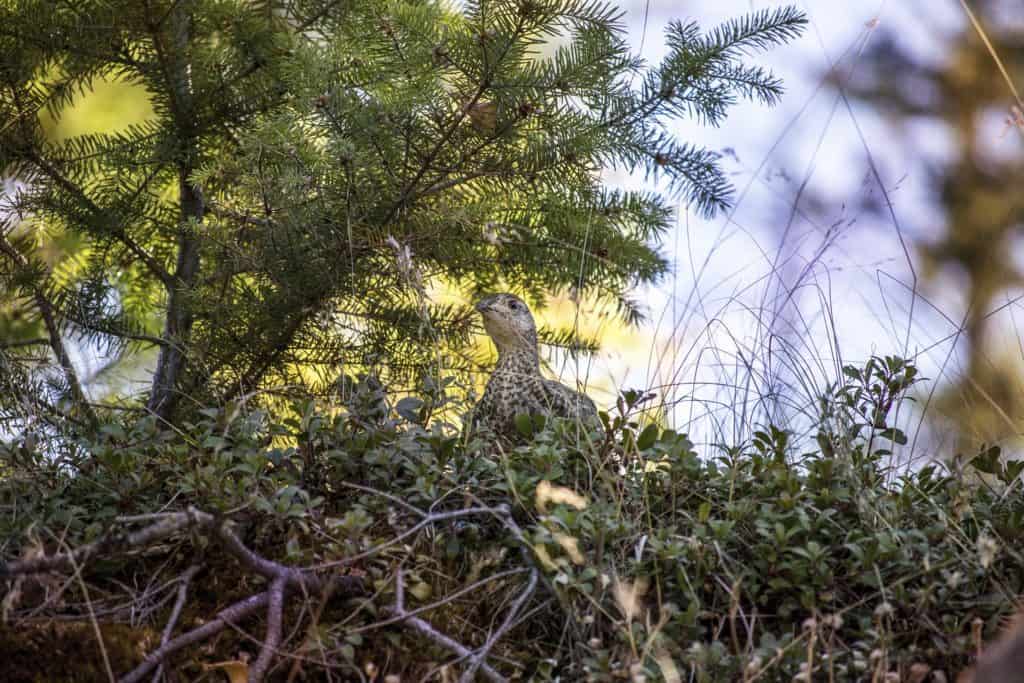
While grouse are known for their holding ability, they are also an incredibly anxious species. This is why it is very difficult to catch and transport Ruffed Grouse from one location to another for conservation purposes.
Grouse will sometimes whip themselves into such a frenzy that they will engage in erratic behavior known as “crazy flights.” As many can attest, some have reported grouse flying with such volatility that they fly right into the sides of buildings or into the fronts of cars, resulting in their own demise.
In fact, my Dad once reported looking out the window of his classroom in high school and being both shocked and perplexed by seeing a dead Ruffed Grouse lying on the roof! This gives you a bit of a glimpse into the temperament of a typical grouse and how we might go about understanding how to hunt them.
Since we understand the mindset of the grouse, we can roll out our strategy for putting more in our game bag. The lack of a dog will mean that we need to change our tactics a bit to make up for what a dog typically provides.
One way to do that is by slowing down. Way down.
You see, grouse thrive in very thick cover. To be able to flush more grouse means we need to be thorough in the ground that we cover, taking the time to go over every little brush pile or Aspen stand so that we are sure not to walk right past that bird that holds very tightly.
The slower and more painstaking you are in rooting out birds, the more likely you are to flush birds and be successful.
Starting and Stopping
Another thing to consider is the art of starting and stopping when hunting. Because grouse are so anxious and erratic, they don’t like sudden changes in their purview.
Covering a certain amount of ground at one time and stopping abruptly will cause many grouse to become very nervous. This anxiety will cause them to flush in light of their uncertainty about a threat.
In light of this, try covering ground in 20-yard increments, and then stop for 10-15 seconds before covering your next patch of ground.
Breaking up your hunting in this way will make the birds very apprehensive and will help to get them in the air. Be ready to fire as soon as you stop, as these birds will come up very quickly and abruptly amid the silence of your pause.
Being ready to snap shoot is crucial, so be sure to have your gun primed and ready to shoot when you take your 10 to 15-second pauses.
It will take some getting used to at first, but once you master this technique, it will become second nature to you and sharpen your skills as a grouse hunter in general, much less as a hunter without a dog.
Keep Your Head on a Swivel
If you could boil all of grouse hunting down to a single principle, it could be aptly summed up with awareness. There are few other attributes that fully capture the grouse hunting repertoire.
Simply put, you must always have your head on a swivel if you want to have any success at all as a grouse hunter; dog or no dog, but especially for the person hunting without one.
This means that you have to be ready at all times, as the thunderous fury of that flushing grouse will scare you to death if you’re not ready for it. If you’re not ready to shoot, the whole thing will be over before you can even determine what is going on.
If you’re hunting without a dog, having your head on a swivel may take different forms depending on your situation. For example, make sure you’re also scanning the forest floor. It is common that you’ll sometimes catch a glimpse of a waddling grouse just before it takes flight.
If you can spot one just before the flush, you’ll be in a great position to connect on a shot once the bird takes flight. Another thing to consider is whether or not is raining or has just recently rained.
In this case, you will often find grouse that have taken refuge in trees, and so being aware of surrounding spruce, cedar, and other pine will give you an advantage incase grouse have temporarily roosted in these places.
For this reason, scan the tree lines in case a surprise flush takes off from them. That way you’re not caught off guard and can make a quick adjustment if need be.
Remember, awareness is key, so as long as you know where you are at all times, your productivity will increase.
Conclusion
With or without a dog, grouse hunting is not for the faint of heart. It is an elite challenge that demands much from those who pursue this majestic game bird.
That is what makes every flush memorable, and every single grouse harvested special. I can still remember every flush and shot I have ever taken, and I can say with certainty that if you ever harvest a ruffed grouse you’ve truly done something worthwhile – with or without a dog.
Yet, there is something to be said for the lone grouse gunner who comes home with a full game bag without the help of an old Setter. That person has truly stepped up to the challenge and delivered.

